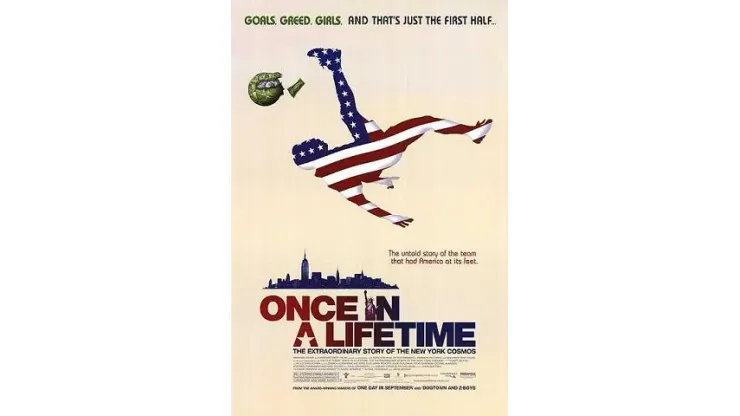Pele, Franz Beckenbauer, Carlos Alberto, Giorgio Chinaglia – The New York Cosmos. The mission: conquer America. Once In A Lifetime (2006) is the documentary film about the rise and fall of the North American Soccer League (NASL) told from the mouths and memories and seen through the eyes of players and staff from the New York Cosmos. The film takes an in depth look at the short history of the league, growth, peak and ultimate demise and dissolution of the league.
The Cosmos were the brainchild of Steve Ross, Godfather of American soccer, CEO, President and Chairman of Warner Communications. Warner was responsoble for American institutions the likes of Atari, DC Comics, Sports Illustrated, Atlantic Records and of course the Warner Bros. studio in Hollywood. Ross always had a passion for soccer though and set out in 1971 to bring soccer to the masses in the United States. He wouldn’t rest and he wouldn’t give up until he saw soccer succeed and he planned on spending whatever it took to make it happen.
In 1966, the World Cup Final between eventual winners England and West Germany was broadcast live in the United States by the BBC. The match remains to this day, the most viewed broadcast in the history of the BBC. But what that broadcast did in these United States was to further the introduction of the game to Americans on a massive scale. In the 1960’s, there was no passion for soccer in America because it simply didn’t exist. There were no youth leagues, professional leagues, no feeds coming from Europe to broadcast the English game or Spanish game. Nothing. Steve Ross changed that.
Ross set out to bring the best footballer on the planet to America in hopes he’d help attract other players to do the same and more importantly bring fans to stadiums. The exorbitant sum payed to Pele to leave Brazil and former club Santos seems, at least from the film’s perspective, a mystery. Regardless, it was in the millions and Pele came – and more players came – and fans came – and then more fans came. Ross was on his way to achieving his dream, but the league lacked that one vital ingredient in becoming a legitimate sports league in America, the lucrative television contract.
At the height of the league’s popularity in 1979, the NASL entered into contract talks and were eventually successful in negotioations with ABC. Without giving too much of the film away, what failed probably could have been avoided. The question that ultimately surfaces is, was America really ready for a professional soccer league on TV? And for those who remember back to the national NASL broadcast days, in your opinion, what was it about the broadcasts that didn’t work?
The meat of the film itself covers the arrival and playing days of Pele and the much maligned Chinaglia. Love him or hate him, he definitely comes across as the antagonist to Pele’s protagonist. But he did score goals and the Cosmos were a force when at their best. Once In A Lifetime is a quality film and an interesting documentary. It’s expertly edited and contains in-depth interviews interspersed with symphonic and almost balletic images of on the field play. If you’ve not seen it, the film comes highly recommended and is available on DVD. For Americans who are fans of the beautiful game, the film is an essentially history lesson of the sport in your country. See it!
It could be argued (probably futilely) that in the 1970’s, soccer reached the pinnacle of popularity in America. Regardless of your stance, one thing was certain, the New York Cosmos were the Real Madrid, the Manchester United and the Brazil ’70 to soccer fans in the States. Steve Ross had a dream and I believe he achieved at least a portion of that dream. The ultimate dissolution of the NASL directly paved the way for the boom of youth soccer across the country in the 1980’s. I was one of the millions of children in the 80’s who benefited from these youth leagues. Ross was instrumental in bringing the growth to this country and I salute him for that.
200+ Channels With Sports & News
- Starting price: $33/mo. for fubo Latino Package
- Watch Premier League, Women’s World Cup, Euro 2024 & Gold Cup
The New Home of MLS
- Price: $14.99/mo. for MLS Season Pass
- Watch every MLS game including playoffs & Leagues Cup
Many Sports & ESPN Originals
- Price: $10.99/mo. (or get ESPN+, Hulu & Disney+ for $14.99/mo.)
- Features Bundesliga, LaLiga, Championship, & FA Cup
2,000+ soccer games per year
- Price: $5.99/mo
- Features Champions League, Serie A, Europa League & Brasileirāo
175 Premier League Games & PL TV
- Starting price: $5.99/mo. for Peacock Premium
- Watch 175 exclusive EPL games per season






